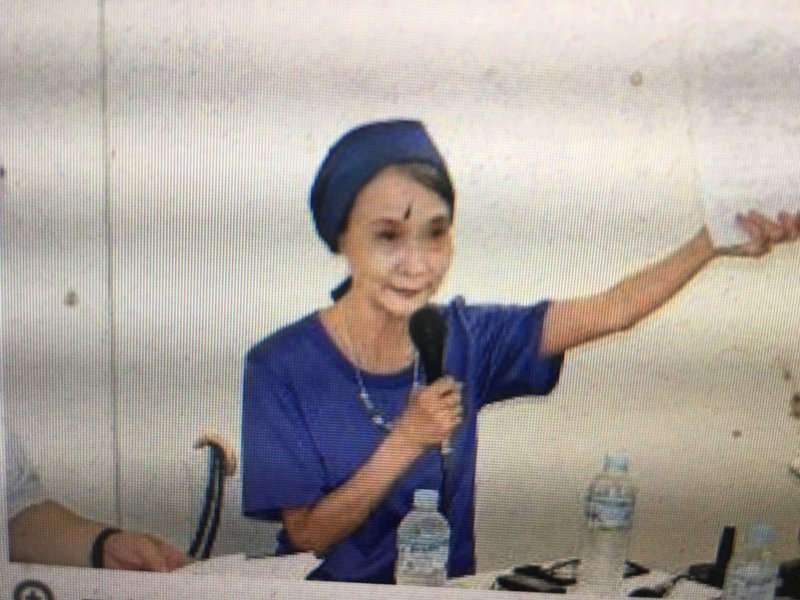
Place Tokyo News Letter NO18: Dr Chizuko Ikegami 池上千寿子 memorial October-1998 "At last so many GAP"
(訳者、解説。この問題は20年前から、あまりフェーズは変わっておらず、2019年依然として最前線の問題です)
12th International AIDS Conference, Geneva Report
2 years ago, the Vancouver meeting was held under “ONE WORLD ONE HOPE”, a new cocktail therapy, its effects (Virus Load has fallen below the detection limit!) Are being promoted. "No HOPE" became the secret behind. No matter how much antiviral drugs can be made, only 5% of infected people benefit from it! It is only a rich infected people in the north-country. What a disparity. It cannot be left unattended. Don't do that. So the Geneva conference 2 years later was “Bridging the GAP” and the conference newspaper was “BRIDGE”. However, who received full organization scholarship at Geneva in Switzerland (Hotel fee $ 300 register fee $ 1,200) (centred on participants from infected & developing countries) are youse hotels in the 6 people. There was no privacy of the gap in Geneva was awesome in the first place.
“GAP that I wanna write note” is “North & South”, “Developing & Poor Countries”, “Poverty & Rich”, “Infected & Non-Infected”, “Academism & Community”, “Professional & Non-expert”, “Male & Female” "Gay & Hetero", "Adults & Children", "Doctors & Patients", "Government & NGOs", etcetera, et al. There will be a “GAP that is surely born” and a “GAP that seems to be pleasing”. For example, the International AIDS Conference is very unique in that it is operated by research organizations, NGO organizations, HIV-patient organizations, However, it can be said “representation of intention to close the GAP”. In one phrase, the impression of participating in such a Geneva meeting was "GAP was serious".
"Confrontation prevention mother-child transmission(PMCT) and/or Female-Care"
The representative of the organizing committee of the Geneva conference was a gender pair (women is the person in charge of the community). She (Robin Gorda) said that her mother-to-child transmission can now be almost prevented, She also benefited Poor countries. The development cooperation program to bring is introduced. Statistically, this may greatly prevent the infection of newborns, “but what will the woman, can do that” She said. The women are applauding. The prevention of mother-to-child transmission(PMCT) the QOL of infected women could have serious contradictions, rather than a “GAP”. The day after the opening ceremony, the plenary of the meeting started with a hot debate between 2 women.
First, American researcher Lin Moffenson reduced maternal infection to 7% for vaginal delivery, 1% for cesarean section (18% each without treatment) with AZT treatment for pregnant women, and the Viral-Load for pregnant women was 10,000 μl/copie. 1% if below, and 10% above 40,000μl/copie. A Thai experience with international cooperation reported that AZT during the second trimester and parturition reduced mother-to-child transmission by half (19%) and reduced to 9% by artificial nutrition(Powder milk).
However, 32% of pregnant women around the world don't have care that doesn't even deliver, or 43% actually deliver without an expert. Sadly, Mercy McLaughmena from South Africa: “My daughter was given AZT, but the doctors doesn't tell me about any side effects of the drug while I gave breastfeeding. I immediately got well when I quit AZT, but my daughter died the day after I started coughing badly & went to the hospital. She's continues: “Women need to get the best information about AIDS from doctors.” “Why doctors doesn't think about the whole life of women over the long term?” “Doctors get off the stage right away. However, Woman is left behind, and the Woman must weave new clothes by herself with only the thread that has been torn apart.
`` Birth a healthy child VS. People Living HIV (PLHIV)”
Target for the prevention of mother-to-child (PMTC) is women in Africa and/or Asia (less than 5% in developed countries and 30% in Poor countries). Last year, there were 550,000 cases of PMTC, 30-50% of PMTC in Poor countries. Therefore, AZT administration, cesarean section, and artificial POWDER MILK appear in three kinds of sacred treasures. Then, PMTC can be prevented. At a joint meeting between the ICW (International Women's Infectious Network) the IAS (International AIDS Society) Women's Committee, many women were concerned about these 3 sacred treasures. (1) Many pregnant women in Poor countries don't know the fact of infection. → There is no counselling or information provision, only the screening of pregnant women is being carried out under the name of infection prevention. (2) There is no antiviral agent → If the Medicine is administered with international cooperation only for the prevention of PMTC there is no treatment before or after that, women can only have medicine resistance. A poor pregnant woman needs vitamins, not AZT. (3) Even if you know the infection, choose breast milk → Breast milk is safe and free, breastfeeding is a social and cultural Stereotype. → It's like being able to put on an AIDS badge just because you never breastfeed → People's privacy is not protected Mother is exposed to stigma. (4)Does the cesarean section safe? → How safe is a cesarean section in the absence of care during pregnancy and the quality of medical care, and is the prognosis of cesarean section research for women in Poor countries?
5) The danger of artificial nutrition(Powder Milk) → How long will we provide artificial nutrition through international cooperation? In Vietnam, the cost of milk for a year falls to GDP per capita. The problem is not only milk but also contaminated water. While breastfeeding can also be a contraceptive, Women need to be further contraceptive with artificial nutrition(Powder Milk). (expensive! can not!)
(6) What will happen to the treatment and care for infected-women or mothers → The reality that women themselves will not be given information, treatment or counselling will be left behind by their families if their husbands die is completely unchanged. (7) Who will raise the child after the mother's death → The biggest concern of women who became mothers is that doctors, international organizations, pharmaceutical companies and society do nothing.
Use 1 phrase, infected and pregnant women can only be treated as `` the next generation of viruses that pass the virus '', only `` how to give birth to an uninfected child '' is asked, reducing the numerical value is the `` first priority issue '' "And only the impression that" the woman herself remains forgotten "remains intensely. What do you think about GAP?
UNAIDS estimates that the cost of reducing the number of PMTC depends on how prevalent HIV infection is. For example, in Tanzania, the cost of avoiding an infected child with testing and counselling for pregnant women and short-term antiviral therapy is less than $ 600, and the cost of approximately $ 30 for each new-born child. It is almost the same. However, in infectious endemic areas such as Thailand, this jumps to the $ 2800, double the cost of care for children born after infection.
I don't know exactly how to calculate that, but international cooperation comes with a cost calculation. Therefore, “sorting” is also required to provide medicine. “We will provide antiviral-drugs to 80 infected people for only 3 years, but how to choose 80 per. If 3 years have passed, it is better if you said "Say-Good-Bye" from the beginning. An infected person in Africa murmurs In Brazil, the implementation of cocktail therapy(ART) through an international cooperation program with the World Bank was announced as a “specific plan to close the GAP”. “But, there are a lot of people who aren't in a nutritional state that can respond to the strong side effects of antiviral-drugs in the first place. Basic hygiene and nutrition are ahead of medicine. And this expensive medicine is not free. "It ’s going to rebound from the tax on the Brazil-country."
(Down picture Dr Chizuko Ikegami 写真:池上千寿子氏)

第12回国際エイズ会議、ジュネーブ報告
2年前のバンクーバー会議は「ONE WORLD ONE HOPE」というテーマでで開催され、新たなカクテル療法とその効果(血中ウイルス量が検出限界地以下に下がった!)が喧伝される中「Third World, No HOPE」が裏の合言葉になった。いくら抗ウイルス薬が出来たって、その恩恵にあずかれるのは感染者のわずか5%!北の国のリッチな感染者でしかない。 何たる格差。とうてい放置はできません。してはいけません。というわけで2年後のジュネーブ会議のテーマは「Bridging the GAP」会議新聞は「BRIDGE」でありました。でも、世界1物価の高いスイスのジュネーブ、(Hotel fee $300 register fee $1,200)で組織委員会のフルスカラシップを受けた人(感染者や途上国の参加者中心)は6人部屋のユースホテルにつめこまれプライバシーなし、そもそもジュネーブ内ギャップがすごかった。 「うめたいギャップは」というと「北と南」「開発国と途上国」「貧と富」「陽性者と未陽性者」「アカデミズムとコミュニティー」「専門家と非専門家」「男と女」「ゲイとヘテロ」「大人と子供」「医師と患者」「行政とNGO」エトセトラ、エトセトラ。「たしかにうまれつつあるギャップ」「うまられそうなギャップ」はあるだろう。例えば国際エイズ会議は研究者組織、NGO組織、感染者組織、行政とが手を組んで運営するという点できわめてユニークだけれども、これは「ギャップを埋めたいという意志の表明」だと言える。そんなジュネーブ会議に参加しての印象を一言でいうと「ギャップは深刻」なのでした。
「母子感染予防と女性のケアの対立」
ジュネーブ会議組織委員会の代表は男女のペア(女性はコミュニティ担当責任者)開会式の挨拶にたった彼女(Robin Gorsa)は「母子感染はいまやほとんど予防できる」という研究成果と途上国にも恩恵をもたらす開発協力プログラムを紹介した。統計上はこれで新生児の感染はおおいに防げるかもしれない、「しかし当の女性はそれでいったいどうなるというのだ!」と彼女は訴えた。女性たちは割れんばかりの拍手。母子感染の予防と感染した女性のQOLは「ギャップがうまる」どころか、深刻な矛盾をかかえてしまいかねないのだった。開会式の翌日、会議しょっぱなのプレナリーは女性2人のホットな論戦で始まった。
まずはアメリカの研究者Lin Moffensonが妊婦へのAZT治療で母児感染に膣分娩で7%に、帝王切開で1%に(治療無しでそれぞれ18%)下がること、妊婦のウイルス量が1万μl/copei以下なら1%、4万μl/copei以上で10%になることをあげた。国際協力によるタイの経験では妊娠後期と分娩中のAZTの投薬で母子感染を半減させ(19%)さらに人工栄養で9%にさげたと報告された。 しかし、世界中の妊婦の32%は分娩までいかないケアもうけていず、43%は専門家の立ち会わない分娩をしているのが現実である。 ついでに南アフリカのMercy McLaughmena「私が生んだ娘にはAZTが投与されたが、医師は母乳をあげるなとも薬の副作用のこともいっさい教えてくれなかった。娘は副作用で嘔吐と下痢を繰り返した。AZTをやめたらすぐに元気になった。でもすぐにひどい咳をするようになって病院にかつぎこんだ翌日に娘は死んだ」。彼女は続ける「女性は医師からエイズについてのベストな情報を得ることこそ肝心なのだ」「どうして医師は女性の生活全体を長期にわたって考えてくれないのだろう?」「医師はすぐにステージから降りてしまうが女性は残される。ずたずたに切り裂かれた糸だけを手に、女性はひとりで新しい衣服を織らねばならない。
「健康な子供を生むこと VS HIVとともに生きること」
母子感染予防のターゲットはアフリカとアジアの女性たちだ(先進国の母子感染は5%以下、途上国は30%)。昨年の母子感染は55万例、途上国の母子感染の30~50%母子経由といわれる。そこでAZT投与、帝王切開、人工栄養が3種の神器で登場する。そうすれば母子感染は「防げる」。ICW(国際女性感染者ネットワーク)とIAS(国際エイズ学会)女性部会の合同会議では、この3種の神器への危惧が多くの女性たちから語られた。(1)途上国の妊婦の多くは感染の事実を知らない→カウセリングも情報提供もなく妊婦のスクリーニングだけが感染防止の大義名分で実行されているのではないか。(2)抗ウイルス剤がない→母子感染予防のみの国際協力で薬を投与され、その前も後も治療はないとしたら、女性には薬剤耐性ができるだけである。貧しい妊婦に必要なのは抗ウイルス剤ではなくビタミン剤だ。(3)例え感染を知っても母乳を選ぶ→母乳は安全で無料で母乳保育は社会文化規範である。→母乳を与えないということだけでエイズのバッジをつけられるようなものなのだ→女性のプライバシーは守られずスティグマにさらされる。(4)帝王切開は安全か→妊娠中のケアもなく医療の質も不安なところで帝王切開はどれほど安全か、途上国の女性にとって帝王切開の予後は研究されているのか。
(5)人工栄養の危険→国際協力によっていつまで人口栄養を提供してくれるのか?Vietnamでは1年間のミルク代は一人当たりのGDPにひってきする。ミルクだけではなく汚染している水が問題なのだ。授乳中は避妊の効果もあるが、人工栄養でさらなる避妊をしなければならない。(高い、出来ない)
(6)感染した女性、母親への治療やケアはどうなるのか→女性自身には情報も治療もカウンセリングも与えられず、夫が死ねば家族から放置されてしまう現実はまったく変わらない。(7)母親の死後子供は誰が育てるのか→母親になった女性の最大の関心事はこれであり、医師も国際機関も製薬会社も社会も何もしてくれない。
一言でいうと感染し妊娠した女性は「次世代にウイルスをうつすまずい存在」としか扱われず、「いかに未感染の子を産むか」だけが問われ、数値をさげることが「最優先課題」になり「女性自身はわすれたままになる」という印象だけが強烈に残ってしまうのだった。いったいこのギャップはなんなのか。
UNAIDSの試算によると、母子感染児をひとり減らすためのコストはHIV感染がどれほど流行しているかによるという。例えばTanzaniaでは妊婦への検査とカウンセリング、短期の抗ウイルス剤療法で感染児童ひとりを回避するコストは$600以下、全新世児ひとりあたりおよそ$30の出費となり、ポリオと3種混合ワクチンのコストとほぼ同じだという。しかし、タイなど感染流行地域ではこれが$2800にはねあがり、感染して生まれた子供のケアコストの2倍になるという。
わたしにはこのような計算方法はまったく不明だけれど、国際協力にはコスト計算がつきまとう。そこで、薬剤を提供するにも「選別」が必要になる。「80人の感染者に3年だけ抗ウイルス剤を提供するというが、80人はどう選ぶのか。3年たったらあばよというなら始めからやらないほうがよい。アフリカのある感染者がこうつぶやいた。ブラジルでも世界銀行との国際協力プログラムによるカクテル療法の実施が「ギャップを埋める具体計画」として発表された。「でもね、そもそも抗ウイルス剤の強い副作用に応じられるような栄養状態ではない人がおおいのよ。薬より基本的衛生と栄養が先なのよ。それにこの高い薬はタダじゃない。結局Brazil国民の税金にはね返るのじゃないの」Brazilからの参加者の声である。
この記事が気に入ったらサポートをしてみませんか?
